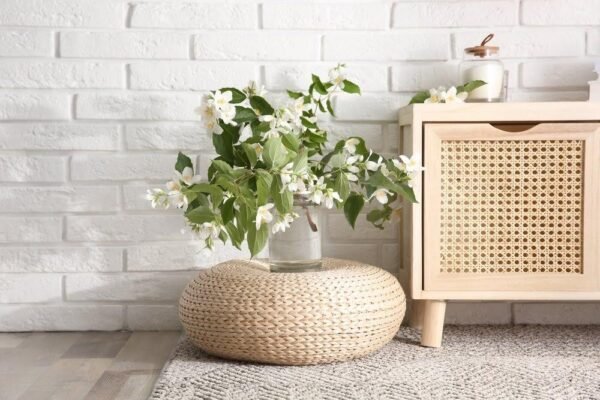
Sleep Psychologist Shares the Seven Best Plants for a Peaceful Slumber
For National Gardening Month (April), Happy Beds have shared the many sleep benefits of adding plants to your bedroom, before sharing their top seven recommendations for a peaceful slumber. They’ve even shared their top care tips for those that will be first-timer plant parents.
Dr Katherine Hall, the sleep psychologist at Happy Beds said, “Many studies have shown that the presence of plants in a bedroom can create many sleep-inducing benefits. Firstly, they help lower a person’s cortisol levels (otherwise known as the stress hormone) by releasing oxygen at night, which helps clear the mind and relax the body.
“In addition, plants help improve the ventilation and humidity of a room, making it easier for a person to breathe at night and, therefore, drift off. This is because plants absorb carbon dioxide and release oxygen through their leaves during photosynthesis. This process means that you’ll breathe fresher air the more plants that you have in your bedroom.
“Similarly, plants release water vapour into the air through their leaves and stems, which helps maintain humidity levels in your home. This is especially important during the hotter months when aircon dries out indoor spaces faster than normal.”
Now that you know the many benefits of adding greenery to your bedroom, read on to see the top eight plant recommendations based on their individual sleep-including side effects.

1. Snake plant
One of the wonderful things about plants is they naturally emit oxygen, which can help purify your air and lead to a better, healthier night’s sleep. Get yourself a snake plant or two for the best air purification. These plants look stylish on a bedside table and remove harmful chemicals from the air, helping with respiration and ensuring you sleep soundly right through till morning.
Care tip: These plants prefer sunlight but can survive in shadier spots, making them a versatile bedroom choice. They don’t need excessive watering. Water a snake plant every few weeks, allowing the soil to dry out between watering.
2. Lavender plant
Lavender has long been recognised as an aid for rest, with natural oils and pillow sprays commonly using this soothing fragrance to promote sleep. But why not go one step further and opt for a lavender plant in your bedroom? You’ll get multiple benefits in one – a pretty plant and a long-lasting, calming fragrance that promotes relaxation from the second you set foot in your bedroom. Place it next to your bed to feel the maximum benefit as you drift off to sleep.
Care tip: Lavender plants like warmer, brighter spots, so make sure your plant is close to a window where it can get plenty of sunshine; ideally, it needs at least eight hours of sun a day to thrive.
3. Aloe vera succulent
Another easy-to-care-for plant that works wonders for air quality – meaning it’s a great choice in your bedroom – is aloe vera. Traditionally used for medicine, aloe vera plants produce plenty of oxygen, so they will help improve air purity and quality in whichever room they’re in. Plus, the fan-like, fleshy leaves make for a unique, interesting-looking plant that will make an instant impression in your space.
Care tip: Aloe vera plants don’t need lots of water as succulents; they maintain water within their leaves. During the spring and summer months, you can water them every 2-3 weeks, and they’ll require even less water through winter.
4. Spider plant
Spider plants are super easy to care for as they only need occasional watering and can survive in indirect sunlight. They’re also a gorgeous-looking plant as they have long leaves that snake out and fan over the edge of the pot, which means they look especially great in hanging pots. Use hooks or pins to hang them from walls or curtain poles for an effortless boho bedroom look.
Care tip: These plants are another great low-maintenance option, making them perfect for the non-green-fingered! They don’t love direct sunlight, so opt for a location with medium light and only water them when the top two inches of soil feel dry.
5. Jasmine plant
This scented option can help promote wellness. The jasmine plant produces a lovely, sweet scent that can help reduce stress and anxiety, ideal for helping you drift off to sleep soundly. It’s also an incredibly pretty plant, with delicate green leaves and attractive white flowers. It will match various décor styles, bringing your bedroom a stylish, chic and sophisticated vibe.
Care tip: Jasmine plants like the sun, so closer to a window is better. Keep an eye on your jasmine plant to see when it’s flowering, as it will need more water than usual.
6. Chinese evergreen
If you’re looking for a leafy green plant with added interest, the Chinese evergreen plant is your answer. This plant has abundant pretty, patterned leaves, making it a great way to add a pop of colour and style to your bedroom. It’s low maintenance – it can survive in low sunlight, making it ideal if your bedroom doesn’t receive much natural light. Chinese evergreen also helps increase oxygen levels in your space, keeping the air fresh and helping promote a healthier night’s sleep.
Care tip: Chinese evergreen plants don’t need too much water to survive, so avoid overwatering. Water the plant only when the soil feels dry to the touch, then allow it to fully dry out again before rewatering.
7. Peace lily
These plants help filter out harmful toxins while also keeping the humidity in your room at a good level, which is an ideal sleeping atmosphere. They can grow to a relatively large size and feature pretty white flowers, making them attractive plants to place in a floor-standing pot or basket to make a statement in your space.
Care tip: Peace lilies can be placed in most locations throughout the bedroom as, although they prefer indirect light, they can also survive in varying light levels. You should water moderately, keeping the soil feeling moist but not soggy.














































